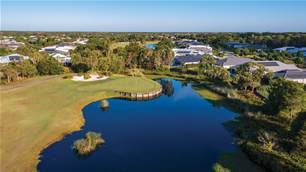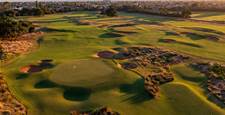There's only one thing better than the weekend and that's a long weekend. Two-day weekends are way too short, which is why we have put our heads together to recommend eight fantastic three-day golfing adventures with plenty of highlights on and off the course.
BARNBOUGLE, TASMANIA
Barnbougle is one of Australia’s, if not the world’s, great golf destinations.
The dramatic Dunes layout, beautifully designed by Tom Doak and Mike Clayton, and Bill Coore’s outstanding Lost Farm course are both listed highly among the best courses on the planet. Then there is the newest addition – the 14-hole Bougle Run short course – which joined its longer neighbours in Golf Australia magazine’s Top-100 Public Access Courses ranking earlier this year.
When Barnbougle Dunes opened in 2004, some questioned its viability saying it was too isolated to attract enough golfers to succeed. Those critics have since been well and truly silenced. Its subsequent success has been based on the model of providing world-class golf on spectacular land and, no matter how isolated, golfers will come.
The 2010 opening of Barnbougle Lost Farm next door further transformed the six-kilometre stretch of north Tassie coastline into a powerhouse golf destination because it appeals to golfers far and wide as both courses fully complement each other.
While both offer their own spectacular golfing attributes and visually striking memories, a poll of golfers who have played both would probably find the votes almost split down the middle as to which course was their favourite.

Where Dunes offers one visually dramatic hole after another, Lost Farm combines the spectacular with holes that place the highest possible value on good strategy and shot execution from tee-to-green.
Dunes is a brilliant layout that encapsulates all that is fun and challenging about links golf.
A round opens with a strong par-5 and par-4 combination, but the real fun begins at the 271-metre par-4 4th, which is known as ‘Homestead’ as the ruins of the original Barnbougle homestead lie beneath the dunes here. The prevailing wind is into your face, but long hitters might be tempted into smashing a drive over a massive bunker on the right edge of the fairway in a bid to find the punchbowl green. It is a huge risk, but the reward is an almost certain birdie if your drive is long enough.
The course winds back to the clubhouse from the 5th tee onwards, with each fairway occupying a corridor beneath and between large dunes. These corridors rise and fall with the natural lie of the dunes land creating a real test for each player’s shot-making ability.
The inward nine is more open but the fairways and greens are easily more affected by the undulating terrain they have been laid upon.

Some of the best and most interesting holes on the back nine cover the most striking topography. For example, the long par-3 13th features a massive, dramatically undulating green that is purely an extension of the rippled fairway. The dramatic putting surface demands a tee shot that needs to finish on the same level as the flag, at the very least not above the cup, or there is every chance you could three- or four-putt.
Unlike Dunes where many of the fairways twist and turn across the flattest land between high sand hills, Lost Farm’s fairways weave through much wider valleys. On the 253-metre par-4 3rd, for example, the fairway is wider than a four-lane highway, but the key is hitting to the right part of the expanse to get the best approach into the angled green. Arguably the best line is to get your tee shot, with a long iron or hybrid, into the right half of the fairway and perhaps onto a raised shelf, which offers a flat lie for the second shot. Into the wind, a well-struck driver might be needed from the tee to find this position.
The 3rd is one of several fun short holes Coore has incorporated into his design. The 124-metre par-3 4th hole is as stunning in its design as the 3rd is strategic. With a tee sitting above the beach, the hole runs along the edge of a sand dune to a huge rolling green on a point, with the ocean to the right and the mouth of the Forester River behind. The exposed nature of the hole may demand anything from a wedge in still conditions to a mid-iron from the tee when the prevailing winds are at their strongest. The tee shot must carry a deep bunker near the green, while other sand traps left and right catch out misguided shots.

And just when you thought you had played enough golf in a weekend, there is Bougle Run.
The 14-hole layout – consisting of 12 par-3s and two short par-4s –and has proven as popular as its big brother and sister. Designed by Bill Coore, Bougle Run is great fun, and some are already calling it the best short course in the world. Time will tell.
Coore’s ingenious design walks the tightrope of not being too hard for beginners and casual golfers, while remaining fun and challenging for the better player. In fact, the shortest tee on every hole has been purposely located to allow players to use a putter only.
While the golf at Barnbougle is unmistakably world class, the quality of the accommodation, the incredible food and wine as well as the amazing setting seduce you back time and time again.
ALL YOU NEED TO KNOW
LOCATION: Bridport, Tasmania.
HOW TO GET THERE: Barnbougle is about 70 minutes’ drive north-east of Launceston. Airport transfer bookings can be made via Barnbougle’s website. Several private airline charters fly direct to Barnbougle from Melbourne’s Moorabbin and Essendon Airports. Again, enquiries can be made via Barnbougle’s website.
GREEN FEES: $149 (18 holes, high season October 1, 2023, to April 30, 2024), $180 (all day golf, one course), $230 (all day golf, two courses). $95 (14 holes, Bougle Run).
WHERE TO STAY: Barnbougle offers several accommodation options including luxury villas, The Dunes Cottages as well as suites in Lost Farm Lodge.
The lodge will have you waking up right on the golf course with stunning views across the Lost Farm layout and the coast. Each of the single and double queen suites is just a short walk from the Lodge Restaurant, Sports bar, spa, clubhouse and, of course, the 1st tee.
The 22 two-bedroom Dunes cottages include a deck with outdoor seating and stunning views of the Dunes course and coastline.
WHERE TO EAT/DRINK: The Lost Farm Restaurant has views of the course and coast that are as stunning as the food, most of which is Tasmanian sourced. There is also a very generous selection of fine Tasmanian and Australian wines from the cellar.
If you head into Bridport, check out the Sugar N’ Spice Bakery and if you are partial to a good pie, try the scallop mornay pie.
WHILE YOU’RE THERE: Seven of Australia’s best cool climate vineyards are a short drive away from Barnbougle. Piper Brook is world renowned for its premium cool climate wines, while next door neighbour Jansz, is home to one of Australia’s most popular sparkling wines. The Dalrymble Vineyard is across the road, while other nearby vineyards include Delamere, Brook Eden, Clover Hill and Bay of Fires.
WEBSITE: www.barnbougle.com.au
MORNINGTON PENINSULA, VICTORIA
Victoria’s Mornington Peninsula offers a smorgasbord of golfing delights with nearly 20 courses spread across the region, many of which are ranked in Australia’s Top-100 Courses.
One weekend getaway we recommend will have you playing, eating, and sleeping in The Cups, an area of the Peninsula once described by five-time Open Champion Peter Thomson as “Mother Nature’s gift to golf.”
The Cups is just 40 minutes’ drive south of Melbourne’s south-eastern suburbs via the Mornington Peninsula Freeway, which means an early Friday afternoon tee time is not out of the question.

Having left your luggage and checked in to the Peppers Moonah Links Resort, you can be standing on the 1st tee of the nearby Open Course within minutes.
Originally designed to host the Australian Open on a regular rotation, the Peter Thomson, Mike Wolveridge and Ross Perrett creation was routed over, through and around rolling sand dunes that are a real feature of this Cups region of the Peninsula.
For the average golfer, the Open layout provides a stiff, but fair, challenge. Thomson liked to refer to the Open Course as a “leviathan” and, indeed, at 6,783 metres from the championship markers it can be a monster. The peninsula is no stranger to strong winds and the Open Course really bares its teeth on such days.
There are more than 80 bunkers scattered across the layout but arguably the toughest hole on the course has no sand at all. From the tips, the par-4 6th measures 403 metres and follows a valley between dunes left and right as it gradually rises to the green. On a calm day the 6th green is a strong drive and a long- or mid-iron away but as the hole runs in a south-westerly direction, into the prevailing wind, it becomes a real brute when there is any hint of a breeze. During the final round of the 2005 Australian Open, few players could reach the green here, but Rod Pampling was successful hitting two full-blooded drivers into the middle of the putting surface.
Conversely, the closing hole – a 582-metre par-5 – is a minefield of bunkers. There are 11 cavernous bunkers lying in the fairway between tee and green. The fairway has also been crafted so its contours feed rolling balls towards some of the sandy pits.
The neighbouring Legends Course – where every hole has been named after an Australian Open Champion – opens with a series of holes that rise and fall through valleys and in between long and dense stretches of ancient Moonah trees.
The course then takes on a new complexion as the Moonah trees thin out and wild, rugged bunkering and high sand dunes stand alongside gently rolling fairways.

Very little earth was moved in the creation of the Legends layout, which offers the impression it has been in the ground far longer than just two decades. Perrett’s routing follows the pitch and roll of the land, sticking to the low ground wherever possible, while the bunkering is not only intimidating but adds to the visual appeal of the course.
The Legends layout is home to one of the best short par-4s in Australia. The 272-metre 11th hole is a driveable two-shotter named after South African legend, Bobby Locke. Six bunkers can be found en route, with three near the huge putting surface, while the edges of the green slope towards its middle. The subtle slopes of the green can be difficult to read, which Locke would have enjoyed.
Moonah Links has a lengthy list of impressive neighbouring courses (three of which we will cover in the next issue of Golf Australia) but for this getaway we chose the Tom Doak-designed St Andrews Beach, a few minutes’ drive south of Moonah Links.
This was Doak’s second Australian design behind Barnbougle Dunes and it didn’t disappoint when it opened for play in 2005. Nearly two decades on, it is ranked No.4 in Golf Australia magazine’s Top-100 Public Access Courses in the country.
Doak created a course with plenty of space, making it very playable and enjoyable for all golfers. For the better player the key is in the playing lines from the tees and the angles those lines subsequently leave into the greens. Some holes are wide open and exposed; others funnel between dunes or between stands of untouched vegetation.

The bunkering is wild and rugged, while the often-dramatic green complexes gather or repel a bouncing approach shot depending on the line of attack.
The American’s minimalist design philosophy where you simply tweak what nature has provided has given rise to some outstanding holes at St Andrews Beach.
For example, when a natural split-level fairway was exposed by clearing scrub, Doak turned it into a brilliant short par-4. The 276-metre 14th features a tiny green – by modern standards – sitting at the end of a wide, split-level fairway and is surrounded on three sides by dunes. The right side of the putting surface features a steep drop off, which can repel a miss-hit nearly 15 metres down a hill into high, wispy rough. This is a wonderful hole that can be played three or four different ways and all result in the same score.
You won’t find this hole, or any of the other 17 holes, anywhere else on the Peninsula or anywhere else in the world for that matter. St Andrews Beach is a wonderful original.
ALL YOU NEED TO KNOW
LOCATION: The Cups, Mornington Peninsula, Victoria.
HOW TO GET THERE: The Cups is about 40 minutes’ drive south of Melbourne’s south-eastern suburbs via the Mornington Peninsula Freeway.
GREEN FEES: Moonah Links – $125 (18 holes, October 1 to April 30), $250 (all day play). St Andrews Beach – $105 (18 holes).
WHERE TO STAY: Peppers Moonah Links Resort is located between the Open and Legends Courses, just a short walk from the clubhouse.
This stylish resort has landscaped garden views outside your deluxe room or suite, while Pebbles Restaurant offers an exceptional dining experience with a modern Australian menu and course vistas.
WHERE TO EAT/DRINK: The Mornington Peninsula is a wine-growing region with at least 50 wineries and just as many cellar doors, so it shouldn’t shock you to discover there are plenty of first-class dining options here, especially at Red Hill, an easy 20-minute drive away. Here you will find acclaimed and award-winning restaurants including Ten Minutes By Tractor, The Epicurean Red Hill and the brilliant Tedesca Osteria.
If you’re looking for somewhere closer to the resort, the St Andrews Beach Brewery is perfect. The property here once housed nearly 80 thoroughbred horses in its stables including champions Makybe Diva, Mummify and Alinghi. Today, the brewery is the centrepiece and has gained a reputation for great beers and seltzers, as well as a wonderful restaurant menu.
WHILE YOU’RE THERE: Immerse yourself in geothermal mineral springs at Peninsula Hot Springs, which can be found next door to Moonah Links. Geothermal mineral springs contain various healing properties that contribute significantly to your overall health and wellbeing, which might be in order after a weekend of golf.
WEBSITES: www.moonahlinks.com.au; www.standrewsbeachgolf.com.au.
Related Articles

The Great Golf Weekend Guide Part II

Travel Feature: Golf’s Sunny Side
International Travel: New kid on the block – Chhun On
Latest News

'Really cool': Herbert gives Australia nine Open lives

Smylie to defend Australian PGA Championship crown

Golf Improvement Tour of Glorious Vietnam
Most Read

RANKING: Australia's Top-100 Public Access Courses for 2025

RANKING: Australia's Top-100 Courses for 2024

Rocket Classic tee times (AEST): Aussies Lee, Davis, Vilips and Baddeley in action






